Crime? No, It Wasn’t Really Crime’: Using Oral History and Memoirs to Teach Crime History
| dc.contributor.author | Watkiss-Singleton, Rosalind | |
| dc.date.accessioned | 2017-03-20T15:35:15Z | |
| dc.date.accessioned | 2017-04-11T08:49:53Z | |
| dc.date.available | 2017-03-20T15:35:15Z | |
| dc.date.available | 2017-04-11T08:49:53Z | |
| dc.date.issued | 2014 | |
| dc.identifier.citation |
Watkiss-Singleton, R. (2014) 'Crime? No, It Wasn’t Really Crime’: Using Oral History and Memoirs to Teach Crime History', Law, Crime and History, 4(1), pp.62-82. Available at: https://pearl.plymouth.ac.uk/handle/10026.1/8896 | en_US |
| dc.identifier.issn | 2045-9238 | |
| dc.identifier.uri | http://hdl.handle.net/10026.1/8896 | |
| dc.description.abstract |
This article suggests that oral interviews, autobiographies and memoirs provide a new perspective on the teaching of crime history. Oral testimony can augment the traditional sources which are generally used for this purpose, giving fresh insights into popular attitudes to criminal activities and behaviour. Through the use of interviews, either student-generated or culled from existing oral history archives, the words and opinions of the perpetrators, victims and the general public will allow students and lecturers to supplement existing evidence in a way which will enhance both their critical understanding of behavioural patterns and developments within society. Student motivation may be increased by a closer involvement with the direct evidence of those who have been in some way affected by criminal behaviour and the individuals who have played an active role within the justice system. Comparative studies and the co-operation between students of law, criminology, history or social science can only be enhanced by an interchange of skills, ideas and resources. This article will utilise the evidence from author’s personal investigations as a case study in order to demonstrate some of the memories of crime, and attitudes to criminal behaviour within Black Country communities in the twentieth century. | en_US |
| dc.language.iso | en | en_US |
| dc.publisher | University of Plymouth | |
| dc.rights | Attribution 4.0 International (CC BY 4.0) | * |
| dc.rights.uri | https://creativecommons.org/licenses/by/4.0/ | * |
| dc.subject | Oral testimony | en_US |
| dc.subject | teaching crime history | en_US |
| dc.subject | cross-curricular cooperation | en_US |
| dc.subject | enhanced skills base | en_US |
| dc.subject | new sources and fresh evidence | en_US |
| dc.subject | case study | en_US |
| dc.subject | perceptions of crime | en_US |
| dc.subject | theft from the workplace | en_US |
| dc.title | Crime? No, It Wasn’t Really Crime’: Using Oral History and Memoirs to Teach Crime History | en_US |
| dc.type | Article | en_US |
| dc.type | Article | |
| plymouth.issue | 1 | |
| plymouth.volume | 4 | |
| plymouth.journal | SOLON Law, Crime and History |




